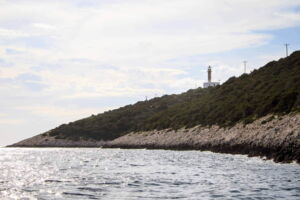Lighthouse and Cap Doukato
The lighthouse of Cape Doukato is a 14-meter-tall (46 ft) lighthouse located on the southernmost point of the island of Lefkada, Greece. It was built in 1890 and is still in use today to guide ships through the Ionian Sea. The lighthouse is made of limestone and has a focal height of 70 meters and has a cylindrical shape. The focal point of the fire is 70 meters and an be seen for 18 nautical miles (33 km). The lighthouse is surrounded by cliffs and offers stunning views of the surrounding area.
The lighthouse is named after Cape Doukato, which is also known as Cape Lefkatas or Kavo tis Kyras. The cape is a popular tourist destination due to its beautiful scenery and its proximity to the beaches of Porto Katsiki and Egremni.
The lighthouse of Cape Doukato is a popular tourist destination and a beautiful sight to behold. It is a reminder of the power of nature and the strength of love.
The best time to visit the lighthouse is during the sunset, when the views are particularly spectacular.
Legend of Sappho
As the legend goes (explained further below), around 580 BC, it is told that Sappho, renowned as the first lyric poet in the annals of world history, supposedly met her demise by falling from the cliffs, driven by unrequited love for Phaon. Her spirit is said to haunt the lighthouse, and some people believe that they can see her silhouette on foggy nights.
During that time, the cape was dedicated to the Greek god Apollo, revered not only as the guardian of sailors but also as a deity representing moral virtue, moderation, prophecy, and artistic endeavors. Regrettably, remnants of the Apollo temple have eroded over time, supplanted by the construction of the lighthouse.
Legend of Kyra of Cape Doukato
According to the legend, a young woman named Kyra fell in love with a sailor. The sailor promised to return to her, but he was shipwrecked and drowned. Kyra went to the cape every day to look for his ship, and eventually she died of a broken heart
The Kyra of the legend of Cape Doukato is a fictional character, not a historical figure. There is no record of any woman named Kyra living on Lefkada in any century, let alone one who died of a broken heart at the lighthouse. The legend is likely a combination of several different stories, including the story of Sappho, the story of the lighthouse's construction, and the natural beauty of the cape.
The legend of Kyra is a reminder of the power of love and loss. It is also a reminder of the importance of storytelling and the power of the human imagination. The legend has been passed down for generations, and it continues to inspire and entertain people today.








